Printing from USB Memory (USB Print)
You can print image files stored in a USB memory device by connecting it directly to the machine. Using this function, you can print without using a computer.

Available File Formats
You can print the following types of image files.
JPEG (DCF/Exif 2.21 or earlier/JFIF)
TIFF (JPEG/MH/MR/MMR compression)
PDF (MF729Cx)
 |
|
For JPEG and TIFF files, maximum printable data size per file* is 50 MB.
* For multi-page TIFF files, maximum data size is per page.
For PDF files, maximum printable data size per file is 2 GB.
Note that even some files smaller than the size described above may not be printed correctly.
|
Available USB Memory Devices
You can use USB memory devices with the following format styles.
FAT16 (memory capacity: up to 2 GB)
FAT32 (memory capacity: up to 32 GB)
 |
|
Do not use non-standard USB memory devices. You may not be able to print the images properly in some USB memory devices.
Do not connect anything other than a USB memory device. USB memory devices cannot be connected via a USB hub or an extension cable.
Do not use USB memory devices with special functions such as built-in security functions.
|
 |
|
The USB port on the front of the machine supports USB 2.0.
If a folder in a USB memory device has many files, scanning image files to print will take more time. Use your computer to delete unnecessary files on your USB memory device or move them to a different folder.
|
1
Connect a USB memory device to the USB port (USB2.0).


Do not remove the USB memory device or shock or shake the device or the machine when data is being read or written. Also, do not turn OFF the machine while the processing is in progress.
2
Press  and tap <Memory Media Print>.
and tap <Memory Media Print>.
 and tap <Memory Media Print>.
and tap <Memory Media Print>.
3
Tap <Select File and Print>.


Index Print
You can print thumbnails of the image files (JPEG only) stored in a USB memory device. To print the images in thumbnails, select <Index Print> on the screen, and proceed to the next step.
4
Select the file to print.
You can select multiple files.

To clear a selection, tap the file you have selected (marked as  ).
).
 ).
).To display the contents of a folder, select a folder, and tap. To return to the folder in the upper level, press  .
.
 .
.
Folders and files lower than the third directory are not displayed.
When you move to another folder, the previous file selections will be cleared.
 To select all files
To select all files
|
1
|
Tap <All Items>.
 |
|
2
|
Tap <Select All>.
 To clear all selections, tap <Clear All>.
|
|
3
|
Tap <JPEG/TIFF> or <PDF>.
All JPEG/TIFF or PDF format files are selected.
  If you selected a file before you tap <All Items>, you can only select files of the same format.
|
 To display previews
To display previews
You can change the display method from <Details> (for file names and modification dates) to <Images> (for previews). By previewing images, you can check the file content before you select a file to print.

Preview images are not displayed for PDF files.
You can specify either <Details> or <Images> as the default display method. Default Display Settings
|
1
|
Tap <All Items>.
 |
||||
|
2
|
Tap <Display Method>.
 |
||||
|
3
|
Tap the display method.
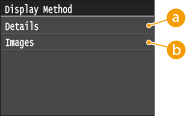  <Details> <Details>
 <Images> <Images>
|
 To change the file sort order
To change the file sort order
You can change the sort order of the files in a USB memory device.

You can specify a sort setting such as <Name (Ascending)> or <Date/Time (Ascending)> as the default setting for the file sort order. File Sort Default Settings
|
1
|
Tap <All Items>.
 |
|
2
|
Tap <Sort Files>.
 |
|
3
|
Tap the criteria for file sorting.
 |
 When you select <Date/Time (Ascending)> or <Date/Time (Descending)>, files are sorted based on the modification dates and time of the files.
|
5
Tap <Apply>.

6
Specify the print settings as necessary.
Tap the item you want to set.

<Number of Copies>
Specify the number of copies from 1 to 99. Tap  /
/ or the numeric keys to enter a quantity, and tap <Apply>.
or the numeric keys to enter a quantity, and tap <Apply>.
 /
/ or the numeric keys to enter a quantity, and tap <Apply>.
or the numeric keys to enter a quantity, and tap <Apply>.
<Paper>
Select the paper to print on.

<N on 1>

<N on 1> is not available for printing TIFF files.
You can print two or four images onto a single sheet. Select <2 on 1> or <4 on 1>.
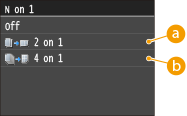
 <2 on 1>
<2 on 1>
Prints two images onto a single sheet.
 <4 on 1>
<4 on 1>
Prints four images onto a single sheet.
<2-Sided> (MF729Cx)
You can make 2-sided printouts. Select the binding position.
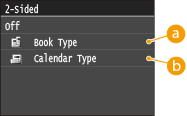
 <Book Type>
<Book Type>
Prints images in such a way that the printed pages are opened horizontally when bound.

 <Calendar Type>
<Calendar Type>
Prints images in such a way that the printed pages are opened vertically when bound.


<2-Sided> may not be available with some sizes or types of paper. Paper
<Set JPEG/TIFF Details>
Specify the default settings of the USB Print function for JPEG and TIFF files.

<Print Date>
If you tap <On>, you can print the modification date of the file below each image.

 Although <Print Date>is not available for Index Print, the modification date of the file is automatically printed below each image.
|
<Print File Name>
If you tap <On>, you can print the file name below each image.

 Although <Print File Name> is not available for Index Print, the file name is automatically printed below each image.
|
<Original Type>
You can select the type of original depending on the image to print. Select <Photo Priority> or <Text Priority>.

 <Photo Priority>
<Photo Priority>
Gives priority to printing photo images smoothly.
 <Text Priority>
<Text Priority>
Gives priority to printing text clearly.
<Brightness>
You can adjust the brightness of printouts. Tap  /
/ to adjust the brightness, and tap <Apply>.
to adjust the brightness, and tap <Apply>.
 /
/ to adjust the brightness, and tap <Apply>.
to adjust the brightness, and tap <Apply>.
 <->
<->
Prints images darker.
 <+>
<+>
Prints images brighter.
 You can adjust the brightness of TIFF files only when they are JPEG-compressed.
|
<Halftones>
You can select the printing method to reproduce halftones (the intermediate range between the lighter and darker areas of an image) for optimal image quality. Tap <Gradation> or <Error Diffusion>.

 <Gradation>
<Gradation>
Prints images with fine gradation, such as digital camera images, with a smooth finish.
 <Error Diffusion>
<Error Diffusion>
Prints images with small text or fine lines with a clear finish.
<Set PDF Details> (MF729Cx)
Specify the default settings of the USB Print function only for PDF files.

<Brightness>
This setting adjusts the brightness of the overall image. The settings can be set between 85% and 115% in increments of 5%. Tap  /
/ to adjust the brightness, and tap <Apply>.
to adjust the brightness, and tap <Apply>.
 /
/ to adjust the brightness, and tap <Apply>.
to adjust the brightness, and tap <Apply>.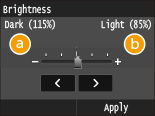
 <->
<->
Prints images darker.
 <+>
<+>
Prints images brighter.
<Enlarge/Reduce to Fit Paper Size>
This setting enlarges or reduces the original document to match the printable area of the paper size.

<Enlarge Print Area>
This setting specifies whether to enlarge the printable area on the paper.

 <Off>
<Off>
The area 1/5" (4 mm) from the top, bottom, left and right edges of the paper is not printable.
 <On>
<On>
The printable area is enlarged to the top, bottom, left, and right edges of the paper.

If you select <On>, images on the edge of the paper may not print properly.
<Print Comments>
This setting specifies whether to print annotations in the PDF file.
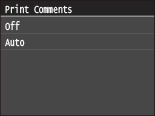
<Password to Open Document>
You can print password protected PDF files by entering the password required to open them.

<Other>
<Halftones>
Specify the data processing method to reproduce halftones.
See Halftones for the description of the setting.
<Pure Black Text>
If the text object is black (R=G=B=0%, C=M=Y=100% or Bk=N%, C=M=Y=0% or Bk=100%), this setting specifies whether the text is printed using black only.
See Pure Black Text for the description of the setting.
<Black Overprint>
This setting allows you to choose a specific way to print black text when printing black text over a color background or graphics.
See Black Overprint for the description of the setting.
<RGB Source Profile>
Select the source profile for color matching to print RGB data, according to the monitor you are using.
See RGB Source Profile for the description of the setting.
<CMYK Simulation Profile>
This setting allows you to specify the simulation target to print the CMYK (Cyan Magenta Yellow blacK) data.
The machine converts CMYK data into a device dependent CMYK color model based on the simulation target selected in the CMYK Simulation Profile.
See CMYK Simulation Profile for the description of the setting.
<Use Grayscale Profile>
This setting allows you to define how device dependent gray data is processed.
See Use Grayscale Profile for the description of the setting.
<Output Profile>
This setting allows you to define the profile that is appropriate for the data you are going to print. It is applied to all data in the print job, so make sure the selected profile is right for your job.
See Output Profile for the description of the setting.
<Matching Method>
This setting allows you to specify a method of printing when the <RGB Source Profile> is applied. This machine includes a color management system that provides the following color rendering styles.
See Matching Method for the description of the setting.
<RGB Pure Black Process>
This setting enables you to specify how black and gray data with the equivalent ratio of R to G to B should be processed when device dependent RGB data is converted into device dependent CMYK data using the <RGB Source Profile> of the machine.
See RGB Pure Black Process for the description of the setting.
<CMYK Pure Black Process>
This setting enables you to specify how monochrome data (C=M=Y=0) should be printed when the device dependent CMYK data is processed using the <CMYK Simulation Profile> of the machine.
See CMYK Pure Black Process for the description of the setting..
<Composite Overprint>
You can overprint device-dependent CMYK data as composite output.
All colors used for data are overlaid and printed on one plate so you can check the finished result without separating the colors.
See Composite Overprint for the description of the setting.
<Advanced Smoothing>
Select how jagged outlines of text and graphics are smoothed. <Smooth 2> applies a stronger smoothing effect than <Smooth 1>. You can apply the setting separately for text and graphics.
See Advanced Smoothing for the description of the setting.
<Grayscale Conversion>
You can select ways to convert color values to a grayscale value when you print color print data.
See Grayscale Conversion for the description of the setting.
<Print Quality>
<Density>(<Density (Fine Adjust)>)
This mode is not available if you set <Toner Save> to <On>.
This setting adjusts the print density.
This setting adjusts the print density.
See Density/Density (Fine Adjust) for the description of the setting.
<Toner Save>
Select whether to reduce toner consumption.
See Toner Save for the description of the setting.
<Special Smoothing Mode>
Select a smoothing mode to print documents with a smooth finish. If you are not satisfied with the printing results of <Mode 1> (default), you can try printing again by using another.
See Special Smoothing Mode for the description of the setting.
<Line Control>
Select the data processing method to reproduce lines.
See Line Control for the description of the setting.
7
Press  .
.
 .
.Printing starts.
If you want to cancel printing, tap <Cancel>  <Yes>
<Yes>
 <Yes>
<Yes>8
Disconnect the USB memory device from the USB port (USB2.0).
|
1
|
Press
 . . |
|
2
|
Press
 . . |
|
3
|
Tap <Device Status>.
|
|
4
|
Tap <Remove Memory Media>.
Wait until the message <The memory media can be safely removed.> is displayed.
|
|
5
|
Disconnect the USB memory device.
|
 |
|
If you always want to print with the same settings: Changing Default USB Print Settings
|

 to display a larger preview. Tap
to display a larger preview. Tap  to return to the original preview size.
to return to the original preview size.